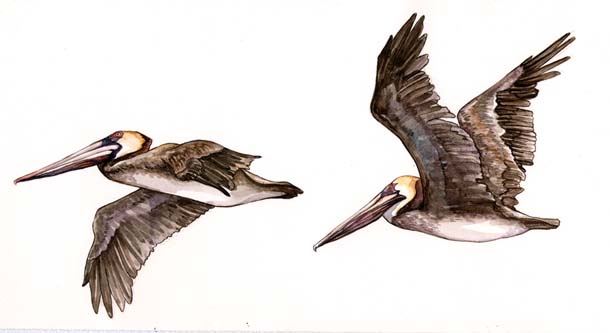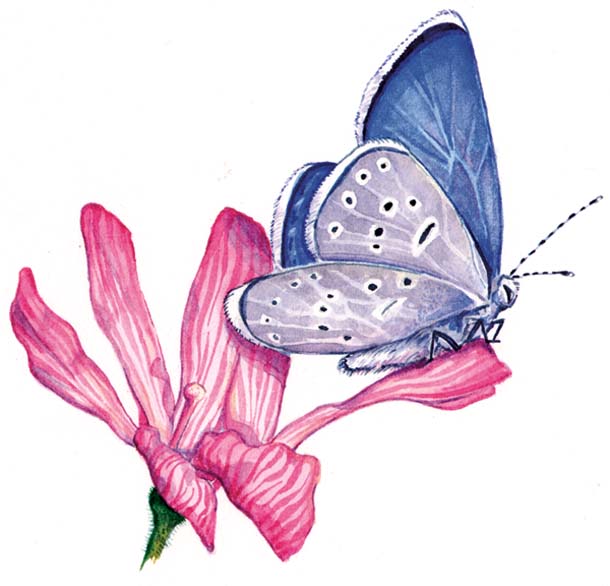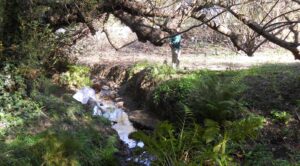Ryan Jones (1978-2008) was a local naturalist, artist, and educator. Fellow naturalist Josiah Clark adapted this article from a tribute he wrote in August 2008, shortly after Jones was struck and killed by a suspected drunk driver as he rode his motorcycle across the Bay Bridge.
Ryan’s artwork and passion for nature drew him to birds. For a time, as luck would have it, that drew him to me. He set his mind on ducks, eager to learn about them, and to paint them. He hoped to win the annual “duck stamp” competition run by the U.S. Fish and Wildlife Service. Taken by his enthusiasm for the subject, I lent him my old spotting scope, a loan I was happy to make permanent. But he was eager to repay the favor: He drew the logo for my business that I still use.
The first time he came to the Christmas bird count at Point Reyes, he showed up at 7 a.m. sharp. It was so cold there was frost on his motorcycle helmet. Ryan never claimed to be a birding expert, but his zeal made him a welcome member of our relatively young team of power birders. We trudged deep into the willows and rushes of Olema Marsh. We were soon among large flocks of birds, and Ryan was among us, swiveling and running this way and that, exuberant and excited. There are few who could have kept up, and honestly even fewer we would have wanted in our company. We were all about the same age, but Ryan still had a kidlike energy and sense of wonder that reawakened the marveling kid in me.
But this was serious work and Ryan knew it. He was determined not to miss a single species, and he was so quick on the draw that I don’t think he did. We found many of the rarest birds on the count that day–Hammond’s flycatcher, evening grosbeak, Nashville and Wilson’s warblers. Seeing them with someone as passionate as Ryan made it all the sweeter.
For Ryan birds and other animals were not just subjects to be studied or check boxes on a list. They were individuals. Even among serious naturalists, this is a rare distinction that I believe cannot be learned. It’s something one feels innately. From the first moment I set foot in the field with Ryan well over a decade ago, I felt his ability to connect with animals. He seemed to attract the most unlikely phenomena like a lightning rod. One of the rarest birds I’ve ever seen, a yellow rail, I saw alongside Ryan. That was the first time I had looked for this species, renowned as one of the nation’s top three most difficult birds to observe. In California its presence is nearly an aberration, with only a few recorded sightings each year. We went to Waldo’s Dike near Inverness, where there have been a few past sightings. At the last possible moment of the year’s highest high tide, a yellow rail presented itself, flushed out of the marsh by the high water.
Our group was the only one to see a yellow rail. Veteran birders, some who’d unsuccessfully sought out the species for 20 years, seemed almost irritated with our beginner’s luck. Ryan made a painting of that moment for me, showing all of the diagnostic field marks of the rail in flight.
Most of us got to know Ryan through the Presidio, where he first visited the native plant nursery on a high school field trip in 1995. “I remember the first time I met with Ryan’s class,” says Sharon Farrell of the Golden Gate National Parks Conservancy. “I was so struck by his conviction and certainty. He wanted to be a park ranger.”
Ryan soon became an intern, then joined the staff in 1998. The work was much more than an occupation for Ryan. He was at the heart of the tight-knit team of Presidio Park Stewards, leading public programs and becoming a cornerstone of the growing stewardship community.
Living in the Presidio, Ryan drank in the wonders of nature each day. “Ryan explored every inch of our park and fell in love with Dragonfly Creek,” Farrell recalls. “He would get up early to draw the damsel- and dragonflies and immerse himself in birdsong. Then he asked to write a management plan to restore the creek. He continually challenged himself, creating his own opportunities.”
In 2002 Ryan left the Presidio to work with the Parks Conservancy’s Site Stewardship Program as the volunteer and education coordinator. By now he was leading two or three educational programs every week. “There was always something to do, something to be found and turned into a lesson,” recalls Sue Gardner, director of the program. “Kids were drawn to him.”
Ryan worked with volunteers and youth from all over the city and region, but it was a new program, Linking Individuals with the Natural Community (LINC), that drove him to more fully embrace a leadership role. The program offered San Francisco high school students job opportunities in the Golden Gate National Recreation Area.
“That first summer was so difficult that Ryan and I almost dropped the program altogether,” says Gardner. “But then the students’ evaluations and personal phone calls began to roll in.” One said “profound experience”; another, “kept me off the streets and out of trouble for the summer”; and a third simply noted that Ryan “changed my life.”
Ryan found that play was the best way to reconnect youth with nature. “The work can wait,” he would say. “The most important thing is for kids to feel connected out here, and then they’ll want to come back to do the work.” Ryan engaged his students through games and team-building exercises.
Ryan loved to fly, whether on a kite board or with model airplanes, and perhaps raptors inspired this passion in him. To learn more, he went straight to the experts, becoming an intern with the Golden Gate Raptor Observatory. As he worked out the subtleties of raptor identification, he conjured up an idea for a revolutionary kind of field guide, which came to be known as a Cyber Bird Guide. This would allow users to look at the bird image in a variety of ways: rotating the 3-d image to see the bird from any angle, changing from adult to juvenile plumage, even making the wings flap.
GGRO director Allen Fish worked with Ryan on the project. Up at Hawk Hill in the Marin Headlands, Fish greets hundreds of people during each fall migration. Hawks stream south overhead but he manages to simultaneously identify the birds and tell me more about Ryan’s work. “He could engage people not yet engaged,” says Fish. “[The Cyber Guide] has the potential to reach a generation of young people who have a decade of experience in 3-D computer gaming, but who’ve never thought of opening a bird book.”
Ryan himself admitted that there were so many things he liked to do it was hard to find time to do them all: habitat restoration, art, dance, model airplane flying, kite boarding.
Ryan’s memorial, at the Presidio’s Officers Club, was filled beyond capacity. Afterward there was a procession to Crissy Field, complete with uniformed National Park Service escorts and a brass band. Ryan’s ashes were set in a cedar-bark canoe he had crafted himself. His kite-boarding buddies waited on the sand, all geared up. The stiff wind filled their sails and in procession they ripped out into the Bay, spreading his ashes as they went. Beyond, out in the channel elegant terns plunged gracefully into the cold, frothy waters.
To learn more about Ryan Jones and contribute to a fund in his honor, go to www.parksconservancy.org or inmemoryofryanjones.blogspot.com.

.jpg)





